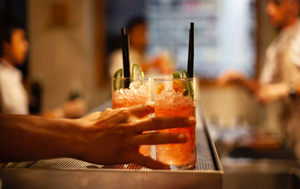Have you heard of ‘dry January’? If you’re unfamiliar with the term, it is the challenge to eliminate alcohol from one’s diet for the whole month of January. Dry January began in 2012 as a public health initiative from Alcohol Change UK, a British charity. Now millions worldwide take part in this health challenge every year.
Heavy and long-term alcohol consumption can result in disease and death so it’s no surprise that consumers want to try and cut back to help improve their health and the wellbeing of those around them. According to the World Health Organization (WHO), the harmful use of alcohol results in the death of three million people every year1. There are 230 different types of diseases where alcohol plays a significant role, including depression, liver disease and cancer, and it also causes harm to the wellbeing and health of people around the drinker, especially if excessive drinking results in aggressive behaviour2.
According to a study in BMJ Open, regular drinkers who abstain from alcohol for 30 days sleep better, have more energy, and lose weight3. They can also lower their blood pressure and cholesterol levels and reduce cancer-related proteins in their blood. Among UK consumers who limited or reduced their alcohol intake over the past 12 months, 43% did so to improve their health, 38% to save money, and 35% to manage their weight4.
Alcohol Change UK’s website offers many different tools and resources to help people stay alcohol-free. There’s an app that tracks dry days plus calories and money saved, a blog and guide with tips and tricks to stay motivated, and special offers from non-alcoholic beverage brands.
If you’ve been looking into reducing your alcohol consumption, you may have decided to stick to water, juice, tea, or soda. However, for those seeking alcohol-free alternatives, there are more options than ever before. Whether it’s mocktails, beer, cider, wine, spirits, or mixers, the marketplace is booming with alcohol-free alternative innovation. In the UK, 58% of consumers drink low/non-alcoholic/alcohol-free drinks more often than alcoholic drinks5. Alcohol-free alternative launches grew +21% from 2016-2021 (CAGR) and the top five innovators include Heineken, Bavaria, Carlsberg, Binding-Brauerei, and Plzensky Prazdroj however, many smaller players have entered the market such as Lyre’s, Mocktails, and Lucky Saint6.
Over the past five years, 50% of alcohol-free alternative launches have contained added sugars7. This will be less than desirable for the increasing number of consumers who are focused on their overall health and wellness. In 2020, 67% of consumers planned to consume less sugar over a period of 12 months, globally 81% of consumers read ingredient labels and 76% read nutrition labels, 74% look at calories and 73% look at total sugars8. In 2021, only 7% of alcohol-free alternative launches contained sweeteners. For example, Heineken’s Gösser brand features an alcohol-free mango-lemon flavoured beer that contains steviol glycosides . Carlsberg added an alcohol-free beer with mango and passionfruit to its Okocim Radler 0.0% range that contains sugar and steviol glycosides9 and Tanqueray now has an alcohol-free gin that contains ace-k and sucralose10 .
44% of UK consumers feel that low/non-alcoholic/alcohol-free drinks taste disappointing but 65% feel that the taste of these products has improved over time11 . In the development of low calorie and reduced alcoholic beverages the addition of high intensity sweetener and a reduction in sugar can change the overall product profile, mouthfeel and taste experience. This can include a change in the flavour character, when sweetness is perceived, a decrease in mouthfeel, addition of off-flavours, and addition of aftertaste. Many of the early alcohol-free alternative products did not address the subtle difference in mouthfeel when alcohol is removed. Formulas have to be created that address the loss of flavour, texture and sweetness to ensure consumer expectations are met.
Ingredients such as natural sweeteners, flavour modifying properties, rare sugars, bulking agents, texturisers and organic acids can be used to maintain great taste in low/no alcoholic and sugar reduced beverages. Natural sweetener solutions such as flavour modifiers produced from the stevia leaf, monk fruit extract and allulose can be leveraged to reduce off-notes and linger while providing a sugar-like sweetness perception. The addition of stevia derived flavour modifiers, fibre and allulose can be a tool to address the loss of mouthfeel when removing sugar or alcohol. Successful sweetening solutions are often built from a combination of ingredients.
It is safe to say that artificial and non-artificial low-calorie sweeteners will become more prevalent in alcohol-free alternative launches and we would expect to see a sharp increase in 2022/23 as consumers seek to reduce both alcohol and sugar consumption without compromising their drinking and taste experiences.
References:
1 https://www.who.int/data/gho/data/themes/global-information-system-on-alcohol-and-health
2 https://www.who.int/data/gho/data/themes/global-information-system-on-alcohol-and-health
4 https://www.health.harvard.edu/blog/thinking-of-trying-dry-january-steps-for-success-202201032662
5 Mintel, Attitudes towards Low- and No-alcohol Drinks - UK - 2021
6 Mintel, Attitudes towards Low- and No-alcohol Drinks - UK - 2021
7 Mintel GNPD 2017-2021
8 Mintel GNPD 2017-2021
9 T&L Proprietary Research, Global, 2020
10 Mintel GNPD
11 Mintel GNPD
12 Mintel, Attitudes towards Low- and No-alcohol Drinks - UK - 2021

